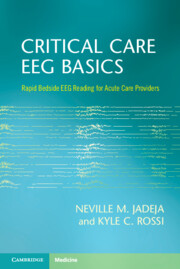Book contents
- Critical Care EEG Basics
- Critical Care EEG Basics
- Copyright page
- Dedication
- Contents
- Foreword
- Preface
- Acknowledgments
- How to Read This Book
- Part I Introduction
- Part II Case-Based Approach to Specific Conditions
- Chapter 9 Nonconvulsive Status Epilepticus (NCSE)
- Chapter 10 Management of the Ictal‐Interictal Continuum (IIC)
- Chapter 11 Seizures and Epileptiform Discharges
- Chapter 12 Seizure Mimics
- Chapter 13 Focal Lesions
- Chapter 14 Encephalopathy
- Chapter 15 Coma
- Appendix Understanding EEG Reports
- Index
- References
Chapter 11 - Seizures and Epileptiform Discharges
from Part II - Case-Based Approach to Specific Conditions
Published online by Cambridge University Press: 22 February 2024
- Critical Care EEG Basics
- Critical Care EEG Basics
- Copyright page
- Dedication
- Contents
- Foreword
- Preface
- Acknowledgments
- How to Read This Book
- Part I Introduction
- Part II Case-Based Approach to Specific Conditions
- Chapter 9 Nonconvulsive Status Epilepticus (NCSE)
- Chapter 10 Management of the Ictal‐Interictal Continuum (IIC)
- Chapter 11 Seizures and Epileptiform Discharges
- Chapter 12 Seizure Mimics
- Chapter 13 Focal Lesions
- Chapter 14 Encephalopathy
- Chapter 15 Coma
- Appendix Understanding EEG Reports
- Index
- References
Summary
This chapter describes recognizing seizures, brief potentially ictal rhythmic discharges (BIRDs), and sporadic epileptiform discharges using a case-based approach. Electrographic seizures are patterns 10 seconds or longer of epileptic activity occurring at >2.5 Hz or other evolving patterns. If these patterns are associated with a clinical correlate, they are called electroclinical seizures, even if they are less than 10 seconds in duration. A high seizure burden may be associated with neurological decline. Patterns of rhythmic activity too short to qualify as seizures are termed BIRDs. Sporadic epileptiform discharges such as spikes or sharp waves are associated with increased seizure risk and epilepsy. Epilepsy itself is a clinical diagnosis of recurrent and unprovoked seizures.
Keywords
- Type
- Chapter
- Information
- Critical Care EEG BasicsRapid Bedside EEG Reading for Acute Care Providers, pp. 160 - 168Publisher: Cambridge University PressPrint publication year: 2024

